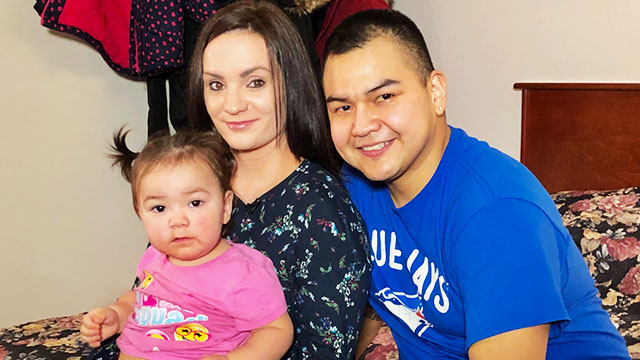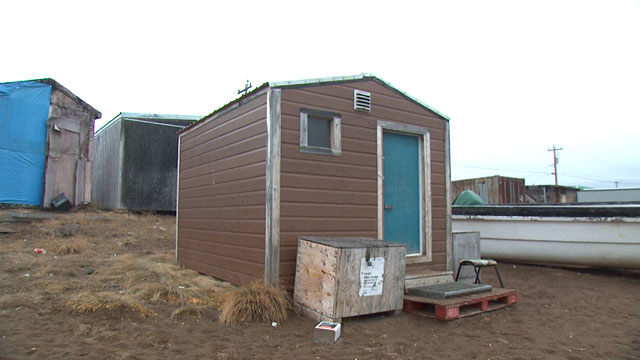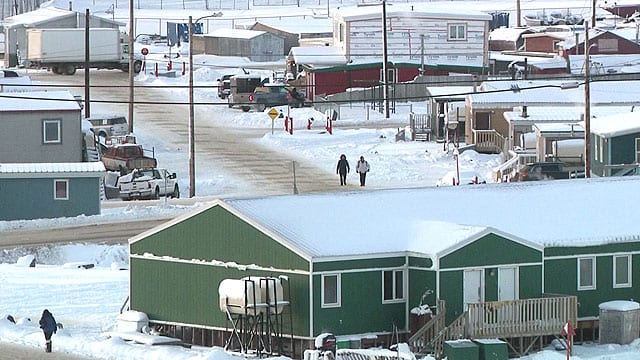Chris MacIntyre, Charlotte Morritt-Jacobs, Kent Driscoll
APTN News
Canada’s three territories are all unique yet they have one thing in common? There isn’t nearly enough housing available and the problem gets worse daily.
APTN’s northern correspondents each took a snapshot of their corner of the world and told a story about the challenges of living in the north without a place to stay.
Yukon
(Angela Ross with her husband Ken and daughter (the other was in daycare) ‘A lot of landlords are taking advantage of the situation,’ she says. Photo: Chris MacIntyre/APTN)
Angela Ross, her husband Ken, and their two children just moved from Faro to Whitehorse.
They couldn’t stay in Faro anymore because they say the black mold on their walls was making the children sick.
They’re paying $1,700 a month to live in a Whitehorse hotel.
That’s the average cost for renting a 1 – 2 basement suite in Whitehorse.
(The hotel where Angela and her family are staying. Photo: Chris MacIntyre/APTN)
They’re living off of disability cheques, so money is tight – so is their room.
Being forced into a hotel means you don’t have a kitchen, eating becomes expensive and unsatisfying.
“We can’t cook like most people do. We have to go out and buy microwave dinners just for the night like we have to go shopping daily. So not only are we spending a lot of money on these dinners – and that adds up especially when you have a family of four – we’re not able to make vegetables,” Angela says.
The 2.4 per cent vacancy rate in Whitehorse means that sometimes you can see the cost of housing go up in real time on your phone.
“Just over a week ago there was somebody on (local Facebook site) Buy and Sell. He had wanted $2,200 a month for a three bedroom. He put the price up to $2,400. A lot of landlords are taking advantage of the situation and it really sucks,” she says. “It’s just making it harder on us. It’s hard enough.”
There are 216 people on the waitlist for 480 affordable social housing units in Whitehorse.
The Yukon Housing Corp. (YHC) says it hopes to have 47 unit building completed by 2021.
According to the YHC, “clients are charged 25 per cent of their gross household income for rent.
Northwest Territories
(‘They get sick more, they fight more,’ says Dan Epp, seen here with his family, including cousins, of the overcrowding in his home. Photo: APTN File)
Dan Epp and Lillian Carpenter live in a three bedroom Yellowknife apartment, with their seven children.
The kids being in such close quarters leads to all sorts of problems.
“They get sick more, they fight more,” explains Epp. “They don’t have space and they need space so they can go and play.
“Everyone is in each other’s face and every time you turn around you are bumping into someone.”
Now try to imagine the logistics of nine people and one washroom. Now add the stress of living in a place that was your own personal crime scene, where you were the victim.
Four years ago, they endured a home invasion and a sexual assault from a neighbour.
NWT Housing told them they would be moved once the neighbour was released from prison. He got out month ago. They’re still there.
“I hope to be moved in a safer area. (This) makes me feel angry and stressed,” says Carpenter.
A recent study by the NWT Bureau of Statistics shows that 42 per cent of residents in the NWT have major problems with affording housing and overcrowding.
It also showed that nearly half of all homes in the territory had at least one housing issue listed as inadequate, unsuitable or unaffordable.
900 people on the waiting list for social housing.
According to the bureau, adequacy was the “main contributor of housing problems” in smaller communities where 50 per cent of homes required “major repairs.”
“Communities with the highest proportion of dwellings requiring major repairs included Colville Lake, Detah, Fort Good Hope, Hay River Dene Reserve, Jean Marie River, Łutselk’e, Nahanni Butte and Wekweètì,” said the report.
Twenty per cent of households in Behchokǫ̀, Colville Lake and Hay River Dene Reserve had “six or more people living in the dwelling and higher rates of suitability problems,” according to the report.
According to the NWT Housing Corporation President Tom Williams, the larger problem is funding, they simply don’t have enough.
“We can’t add to our inventory unless we get a new influx of dollars,” says Williams. “One way around it is partnerships, all levels of government. Federal governments, Indigenous governments and also the private sector has a roll to play and the NGOs.”
Nunavut
(‘It’s harsh for your head, your mind, it hurts from the heart,’ says Eric Tikivik. Photo: APTN File)
Eric Tikivik has been living at the Uquutaq Men’s shelter in Iqaluit for seven years.
He moved back home to Iqaluit after some time in Kimmirut and hasn’t been able to find housing.
After seven years in a shelter, you might expect Tikivik to be bitter – but he is the opposite, he radiates hope.
“It gets really cold out there. Incredibly, people sleep out in qamutiq’s (sleds) or inside a boat, or inside a shack. Its incredible, some people, they survive in this kind of weather,” says Tikivik. “Its harsh for your head, your mind, it hurts from the heart for some people for sure.
“Try to work harder about it, and we’ll get together on it someday, maybe.”
The shelter has just 34 beds, but usually has up to 50 clients.
They’ve held as many as 79 by jamming in couches and foam mattresses.
Not an inch of floor is wasted.
They recently replaced the kitchen tables with folding ones to allow for more floor space. Nothing good comes out of overcrowded housing, but at least they aren’t trying to survive a Nunavut winter outdoors.
In Iqaluit, a two bedroom apartment will cost you almost $2,700 a month.
Even if you could afford it, housing is incredibly scarce in Iqaluit.
Ninety per cent of the private rentals are gobbled up by government and business employees. Jobs in Nunavut are often tied to housing and since governments and businesses are paying the bill, landlords can raise the rent annually.
It isn’t like you can just choose to get a different landlord, there are only so many places.
It is a vicious cycle if you’re employed.
(‘Nothing good comes out of an over crowded house,’ says Nunavut Premier Joe Savikataaq. Photo: APTN File)
Iqaluit is a magnet community for Nunavut, the big city.
Inuit from all over move here, and the Uquutaq Men’s shelter is where the men who fall between the cracks end up.
“People come here, from out of the justice system a lot of times,” explains Uquutaq executive director Laurel McCorriston.
“They’re actually mandated to leave their community and their bail papers often have a condition that they have to stay at the shelter.”
And sometimes people come to Iqaluit for medical treatment (or to escort a patient receiving treatment), and end up staying.
Nunavut Premier Joe Savikataaq says he’s spoken to Prime Minister Justin Trudeau about the situation.
“We’re short right now, as we speak, 3,100 units, and nothing good comes out of an over crowded house. All the negatives and ills that come from a crowded house can be solved by having more houses,” said Savikataaq, as Trudeau stood next to him and nodded.
The numbers are grim. According to government statistics, 27.9 per cent of Nunavut homes have more than one person per room compared to the rest of Canada which sits at 3.4 per cent.
Also, 30.2 per cent of homes need major repairs compared to the rate in the south which his half that at 15.4 per cent.
The Nunavut Housing Corporation says they would need $2 billion just to get caught up to current demand.
Nunavut is scheduled to receive $274.6 million from the federal government for housing over the next nine years.
The numbers are bad, the people caught by those numbers suffer.















